Venice on a budget? Is that even possible?
Agreed, visiting Venice can be pretty pricey.
After all, you find yourself at one of the world’s most unique places – and it comes with a price tag.

However, if you follow my simple hacks, visiting Venice on a budget is easy and still very enjoyable.
I’ve been coming to Venice for years – at least every other year to visit the Biennale di Arte. Consequently, I’m not going there for these overpriced touristy places and services. I enjoy Venice on a budget – and believe me, I enjoy it to the max.
Therefore, in this post, I’m sharing my best tips on when to go, where to stay, what to eat, and more.
Insider Tips to Make Your Stay More Enjoyable
No, I will not surprise you with the information that there is Saint Mark’s Square to be visited, the clock tower to be climbed and many canals to be rowed. You’ll find all this in every guidebook, on each website, or even in the smallest brochure.

I’ll make you Venice-savvy and show you how to get more for less.
When To Go
Yes, thinking of Italy, sole comes to mind. Gelato melting in the sun, running over your fingers, and dripping on your favorite white dress.
Italy is the epitome of summer. And summer is the busiest and most expensive season – I would avoid it at any price. It’s hot, it’s full, it’s expensive.

If you haven’t been to Venice before, you want to stroll through the narrow alleys. You’d like to admire the fantastic architecture and sit on benches in small parks. Then, you should rather pick the shoulder seasons from March to May and September to October.

Even then, you won’t get lonely, but it’s much better than in the summer months.
Venice in Winter
So, you’ve been to Venice before, you have lost your way a hundred times in the narrow alleys and taken a thousand pictures of the scenic squares and structures and now want to see all the great museums, churches, and scuole from the inside. In this case, you can happily come back between November and February. Except the Christmas week and the Carnivale weeks in February.
You’ll find accommodations more easily and you’ll pay a fraction of the summer rate.
However, the whole concept is completely different from summer vacation. It’s quite cold and a rough wind is blowing from the waters. Also, there tends to be acqua alta, the infamous high tide. Then, Venetians have to put up pedestals to be able to walk the streets.

So if you’re coming for the exhibitions, for Tintoretto’s amazing paintings at the Gran Scuola di San Rocco, for Tizian’s Annunciation at the Chiesa di San Salvador, and all the other wonders, this is the time. All the great sights like Saint Mark’s Basilica and the Palazzo Ducale are significantly emptier. Lines are shorter, everything is better.
Also, if you are coming for one of the biennials, it doesn’t matter that much which month you pick. Therefore, you can happily opt for a less sunny period. To get an idea of what this mega-event is all about, check out this post on the last edition of the Biennale di Arte.
How To Get There
Train
From other Italian cities or neighboring European countries, you’ll probably get to Venice by train. Despite all complaints from frequent travellers, Trenitalia, Italy’s national railway company, offers a really good service at very reasonable prices. However, especially on weekends, trains tend to be very full, particularly the regional ones. The only recommendation I’d like to give you is to make a reservation in advance where possible. And to travel as light as you can to be more comfortable.
In Venice, there are two train stations: Mestre on the mainland and Santa Lucia at the historic center. Trains between these two stations are going frequently. Therefore, if you accidentally get off at Mestre, it’s no biggy. The next train will take you to the final stop in a couple of minutes.

Also, if you choose to find accommodation at Mestre, you can get by train to Santa Lucia in about ten minutes. The ticket costs 1,45 €uro. Despite the longer rides and the slightly higher costs, there are a couple of reasons why staying in Mestre is a brilliant idea – I’ll get to that later.
However, if you are an environment-friendly traveller or on a railroad trip across Europe, Venice can be quickly and easily reached for instance from Vienna, Munich, Ljubljana, and even Zurich in about 6 hours. From Vienna, you can even take a sleeper train. How cool is that: You fall asleep in beautiful Vienna and wake up in wonderful Venice!
The Times They Are A-Changin’
Do you remember those days when you had to validate your ticket before boarding the train? I’ll never forget a trip from Venice when I realized about 90 seconds before departure that I hadn’t validated my ticket. Now I had the choice between racing to the machine on the platform and risking the train leaving without me. Or staying on the train with an invalidated ticket and risking the controller fine me.
What did I do? Well, with my heart pounding like crazy, I ran to the machine, had almost a heart attack when the train made this exhaling sound as if it was about to leave, yelled noooo, stamped the ticket, ran back, hopped on the train – off we went.
Well, good news: Those days are over – at least when you buy your ticket online which I highly recommend. Not only can you check in e.g. validate your ticket comfortably on your phone. You can also alter your booking before you check in!
That’s such a great service: You go online, choose your connection, and pay. Then you’ll get an email reminding you that your ticket isn’t valid until you check in online. This is a very easy process including two clicks.
However, you shouldn’t do it too early because until you’re checked in, you can change your ticket free of charge. Been there, done that, worked like a charm.
Therefore, I’d recommend checking in only as you get to the train station.
Bus
Flixbus is conquering the world – at least the world’s European part, hence it’s also serving Venice. It might not be the fastest way to travel, but it’s quite comfortable and definitely the cheapest. For instance from Munich or Vienna, a one-way trip sets you back around 30 €uros, from Rome, it’s only 25 €uros.
The Flixbus stops in Venice are at the Tronchetto parking lot close to the cruise terminal as well as at the Mestre train station.
To check schedules and prices, visit their website.
Flight
If you fly into Venice, you’ll land either at Venezia Marco Polo or Treviso airport.
Treviso is about 40 kilometers from Venice. The easiest way to get either to Mestre or Piazzale Roma at the historic center is by ATVO bus. It takes about an hour and costs 10 €uros one way or 18 €uro if you buy a roundtrip.
Arriving at Marco Polo, you have various options to get to Mestre or the historic center. The ATVO bus #35 takes you there in 20 to 30 minutes for 10 €uros one way or 18 €uros if you buy a roundtrip. An alternative is the ACTV-bus #5 going for the same price to Piazzale Roma and back. To get from the Marco Polo Airport to Mestre, you take either a ATVO bus or the ACTV-bus #15.
A far more spectacular way to travel from Marco Polo to the Centro Storico, Venice’s historic center, is by the Alilaguna boat. Especially on a sunny day, it’s just dreamy and actually the first beautiful sight of your beautiful vacation.

Alilaguna stops at various stations around the main island and then goes to the Lido. So it’s recommendable to check where you’re staying and get off near that spot. A one-way trip by Alilaguna costs 15 €uros to the Centro Storico and the Lido and only 8 €uros if you’re getting off in Murano. The roundtrips will set you back 27 €uros and 15 €uros respectively.
If you choose to go back to the airport by Alilaguna, too, take into consideration that the space on the boat is limited, and if it’s full, it’s full. Since I’m a nervous person, I would not risk it. Also, after having enjoyed the canals for a couple of days in Venice, I can comfortably go back to the airport by bus and be sure to get there on time.
Where to Leave Your Luggage
But what if you’re not staying at the historic center? Then you can still go by boat, but in this case, I’d advise you to get off at the Cruise Terminal (Blue Line) and cross the Ponte della Costituzione to the train station Santa Lucia where you can leave your luggage and start exploring the city right away.
Especially during the summer months, the storage at the main train station Santa Lucia is often full so you have to either wait or choose a privately operated consigne bagagli: A couple of stores offer to store your stuff for a little fee, and there are even various locker rooms at different spots in the center. But be aware that these places close much earlier than the one at the station.
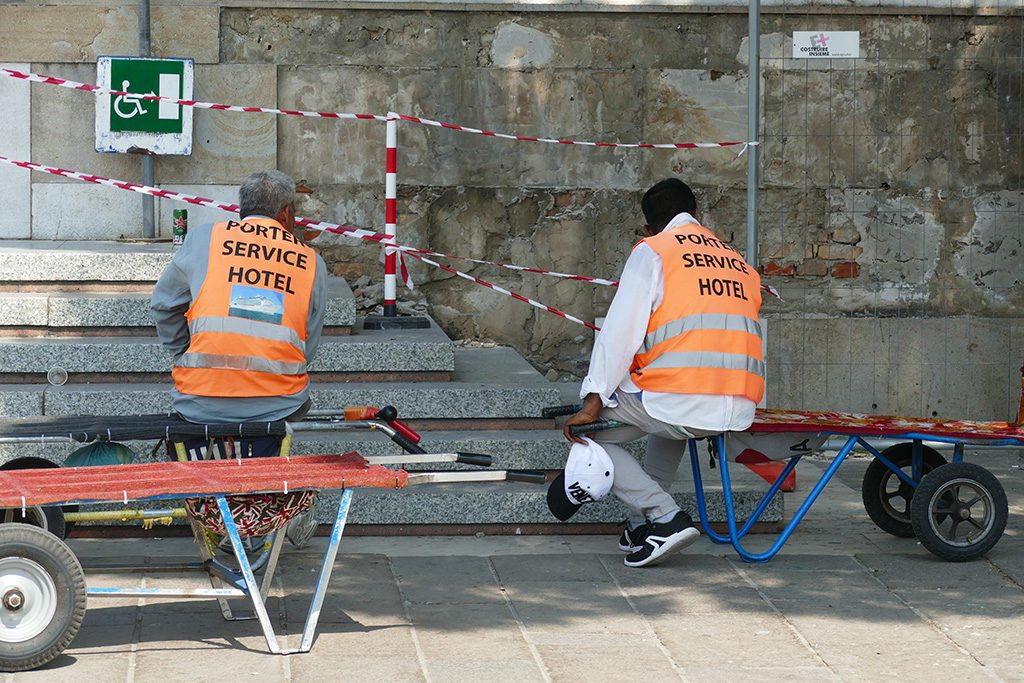
To leave your luggage in a safe spot in the vicinity of the Piazzale Roma – that’s the final stop of all public road traffic to and from Venice – I can recommend the storage place The Golden Luggage. It’s right across from the Vaporetto stops. Prices start at 6 €uros for a small suitcase and go up to 10 €uros per day for a large one. Fair and square.
They are open every day from 8.30 a.m. to 8 p.m. and also offer some touristy services.
Where To Stay
Sleeping at the Centro Storico of Venice
Prices for accommodations are much higher from March to September. In November, I paid a fraction of the high season’s price. Also during the unpopular Winter months, the city is emptier than in Summer – albeit, never abandoned.
I personally experienced the least amount of tourists end of February right after the carnival.
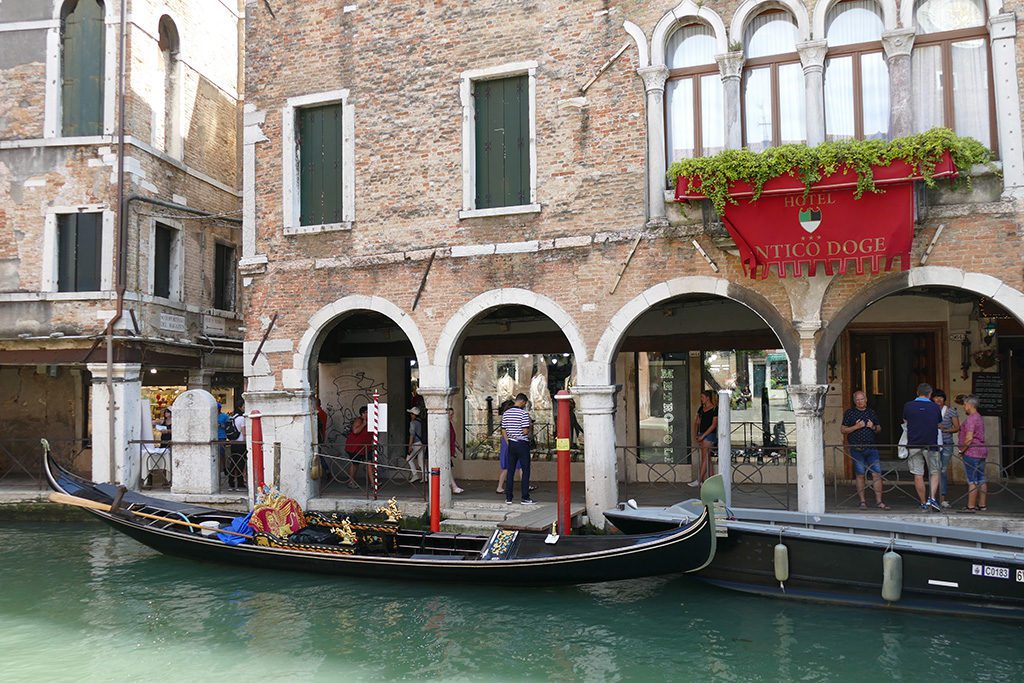
Especially if you’ve been to Venice before and do not need this Venetian overdose, you might want to check out accommodations on the Veneto’s mainland like at the adjacent city of Mestre, or even farther away like Quarto d’Altino.
Although I’ve also witnessed strikes and heard many complaints, I insist that Italy has a comprehensive and reliable system of public transport. Therefore, it is really easy to commute to the historic center and back, I’ve done it during many stays myself.
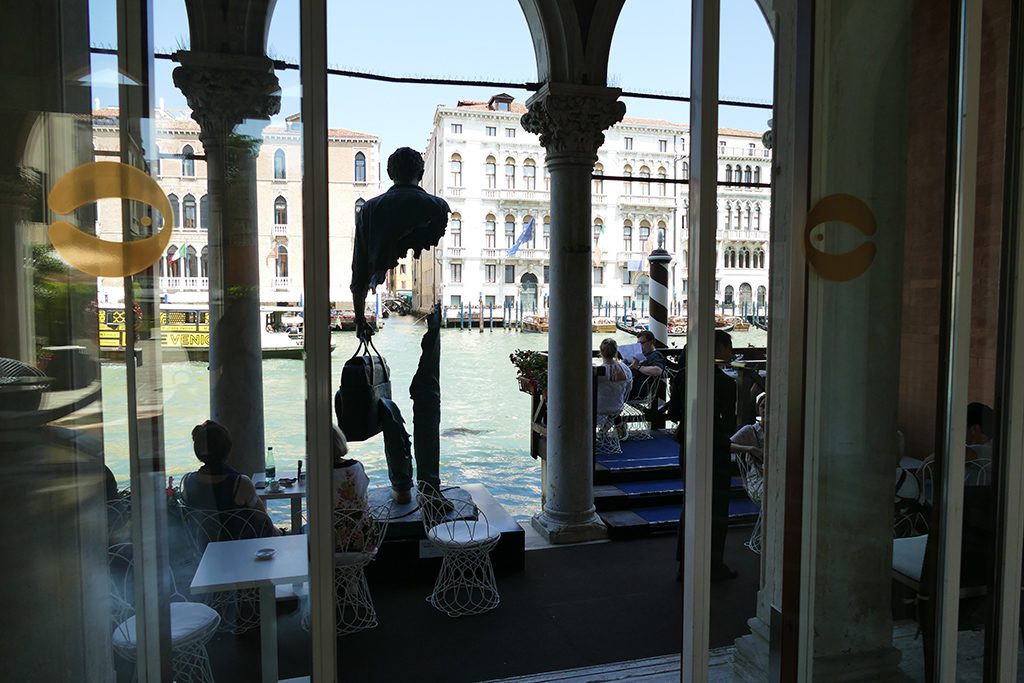
However, I totally understand if you want to stay right in the center of this amazing city. Therefore, here’s a map with some suggestions on where to rest your head*:
Booking.comSleeping in Mestre
The closest and best accessible alternative to the Centro Storico should be Mestre. You can get to Venice Santa Lucia from there by train for 1.45 €uros. But there is also a tram as well as many buses going every couple of minutes for 1.50 €uros for a single trip. If you buy a carnet of ten tickets, you even pay only 1.40 €uros. Also, those buses and trams are included in the travel passes I’ll introduce below.
Although Mestre is less expensive than Venice, it’s not cheap since the trick of staying ten minutes away from the action is not so very genius. Hosts in Mestre are aware of that and know what they can ask from you. However, I’m always paying around 50 €uros per night at small private lodgings respectively self-catering studios.
On this map, you can check out whether there is suitable accommodation for you in Mestre*:
Booking.comSleeping in Quarto d’Altino
Another alternative is the hotels at Quarto d’Altino*, a charmless place less than half an hour by train from Santa Lucia. Surprisingly, there are a couple of houses like the Crowne Plaza* and Best Western Hotel Airvenice* in that area.
The trains to and from Venice go every 30 minutes and one trip costs 3.90 €uro. It’s not the best option, but it’s an alternative just the same. I myself did it twice on really short stays and it was okay. Commuting all the way out there for a longer time, though, might be unnerving.
On this map, you can check out whether there is suitable accommodation for you in Quarto d’Altino*:
Booking.comHow To Get Around
On Land…
As you might know, the Centro Storico and most of the smaller islands in the Venetian lagoon are car-free. Therefore, you simply cannot avoid a lot of walking. As a matter of fact, neither can you avoid taking some kind of boat. You have to take a Vaporetto at least if you want to visit some other islets such as the Giudecca, Isola di San Servolo, or the Isola die San Giorgio Maggiore.

Nevertheless, even if you stay and visit just the landmarks within the very core of the Centro Storico, you cannot avoid walking a lot. On city breaks, I’m used to going for miles and miles. However, in Venice, you’ll walk those miles even if you try to walk as little as possible. If you go only straight from the train station to Saint Mark’s Square, it’s already more than 2.5 kilometers. And yet you have to add all those little detours because you’ve spotted that cute little church or a gelato parlor or as you lost your way. Also, don’t expect that Vaporetto to stop to be right in front of your accommodation. You’ll probably have to cross a couple of bridges to get to your nearest stop.

Therefore, make sure to wear really comfortable shoes, take some breaks, and treat yourself to a Vaporetto ride from time to time even if it’s just for a couple of stops.
Venice has the tacky gondolas, and there are very expensive water taxis. However, there is also a very comprehensive net of Vaporetti which are basically water buses.
…And On Water
Although the Centro Storico, the fish-shaped historic center of Venice can be reached and also explored by walking, this is not an option if you want to visit also the other islands scattered in the Venetian lagoon. There is a total of 120 isles of which only 11 are permanently inhabited. Those, you can reach only by boat.
Fortunately, apart from public land transport, the ACTV transport company has also a comprehensive net of vaporetti, water buses taking you to any place in the lagoon on a regular schedule.

Once the regular Vaporetti are suspended, there are a couple of nightly connections; hence, you never get stuck on any of the islands overnight.
ACTV has an excellent website and even an App for iOS and Android. To get an overview of your options, check out their very neat system map.
Which Ticket to Buy
While at 9.50 €uros, individual tickets are ridiculously expensive, there are travel passes that are actually not that bad. The more days you buy, the cheaper your rides become. Here is a chart on how much you pay for a day pass in 2024:
| 24 hours | 48 hours | 72 hours | 168 hours (7 days) |
| 25 €uros | 35 €uros | 45 €uros | 65 €uros |
Note that a 24-hour ticket can even be used on two days since the clock starts ticking the moment you validate your ticket and lasts actually 24 hours. With the other tickets, it’s the same, obviously.
Rolling Venice
Young people under 29 years of age get an even better deal with the Rolling Venice Card. This title costs 6 €uros and is valid for one whole year. Not only do you get great discounts at many museums and other places of interest. You also pay only 27 €uros for a 72 hours-pass instead of the regular 45 €uros. Unfortunately, you can actually buy only 72 hours-passes. But if you stay for instance for a week, you can get two so that you pay only 54 €uros in total.

The passes are also valid in other parts of the Venetian area like for instance on the buses on the Lido di Venezia and on buses, trains, and the tram in Mestre. All in all, they are a really great deal.
There are passes that include trips from and to the Marco Polo Airport. However, keep in mind that as you activate your pass at the airport, the clock starts ticking. It might be cheaper to pay that extra fee for those trips in order to activate your pass later when you need it for your sightseeing.
Rules And Regulations
In the past, basically no one really cared if you paid for your Vaporetto trip or if you just hopped on the ferry and off you went. Yet, this changed dramatically. During my week in Venice this year, I was checked five times! Also, I witnessed how the inspectors could not be talked into anything or charmed. If a passenger did not have a valid ticket, he had to pay 9.50 €uros for the regular fare plus a fine of 50 €uro.
Nevertheless, the inspectors granted them two options: cash or credit card payment.

Also, here’s a little technical tip: If you have a valid ticket and the turnstile still refuses to let you through when you tap, you’ve definitely tapped at the wrong entrance. At busy stations such as Piazzale Roma or Ferrovia, there are actually two entrances: One for tourists and one for residents. When the Vaporetto arrives, the passengers in the resident queue have priority boarding. I think this is a very practical and fair solution. Since the residents are already so disturbed by the masses of tourists, they should at least have priority when taking the Vaporetto.
So if your perfectly good ticket declines, try the other entrance.
Venice Entrance Fee
Yes, it’s true: In its fight against merciless over-tourism, Venice has installed an entrance fee.
While the visitors are all freaking out and panicking about being thrown into the dungeon forever because they were caught without a valid ticket, the Italians take it rather easy.

It is a pilot project that has been applied on certain days – mostly weekends – since April. You have to pay 5 €uros online if you are in the Centro Storico on the designated days between 8.30 a.m. and 4 p.m. You don’t have to pay anything if you stay overnight in the greater Venice area. That’s for example in Mestre on the mainland. Neither do you have to pay anything if you’re just on the smaller islands like Murano, Burano, Torcello, and the Lido. You also don’t have to pay if you’re just changing buses in Piazzale Rome or trains at Stazione Santa Lucia.
And who controls all that? In my experience, no one.
However, since the amount is really manageable, I would pay it.
You can get more info on this website, and here, you can pay your dues or obtain an exemption.
Discounts
As I said, I will not tell you that the Doge’s Palace and the Rialto Bridge are to be visited.
But I tell you that you can visit sights at a cheaper price and without waiting in line. All you need is the Museum Pass*. It grants you free entrance to the 11 most important state museums and palazzi in Venice. The best way to get it is by ordering it online*, this way, you save even more time.
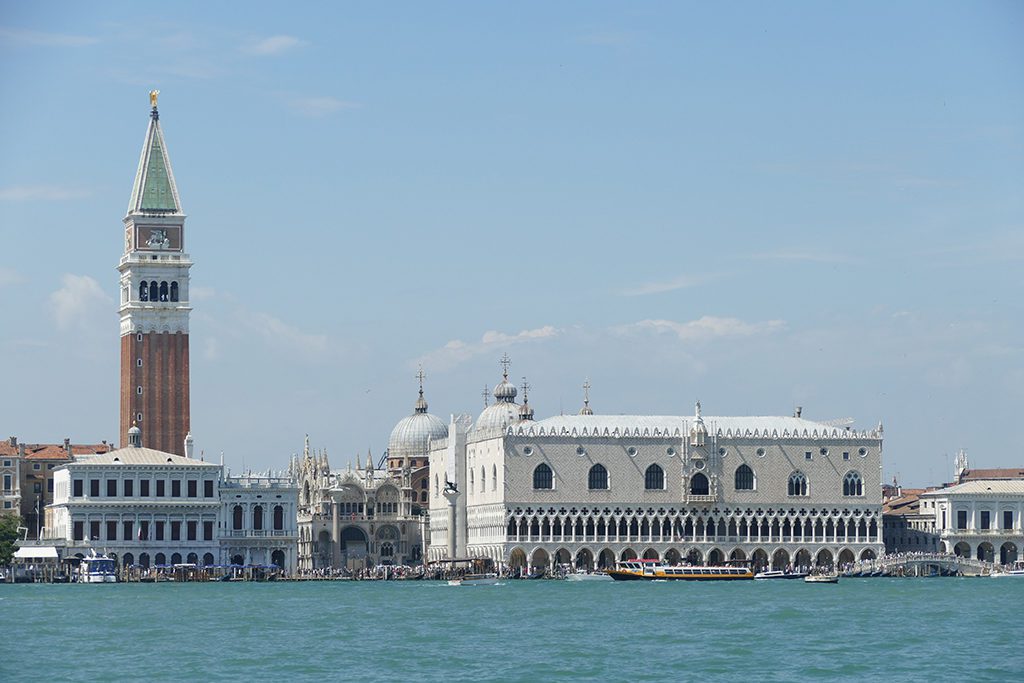
To visit only the landmarks around Saint Mark’s Square, you can obtain a general ticket for 25 €uros. It grants access to the Doge’s Palace, Museo Correr, National Archaeological Museum, and the Biblioteca Nazionale Marciana. With the Rolling Venice Card, it’s only 14 €uros. To visit the Doge’s Palace, you can make an online reservation for a specific day online, however, not for a certain hour. Yet, you’ll be granted priority access.
Keep in mind that especially during high season, saving time should be your priority. You won’t be able to avoid waiting in line at Vaporetti, museums, landmarks, eateries…you name it. So at least try to keep those waiting times as short as possible.
Like in most other touristy cities, there’s a free walking tour in Venice, too. Every day, there is a tour at 10 a.m. as well as at 3 p.m. that takes about two hours. You can book online and meet the group at Campo Santa Maria Gloriosa dei Frari.
Extra-Tip
During the Biennale di Arte, which until the COVID pandemic has taken place every odd-numbered year, many of the old palazzi are housing the so-called country-pavilions. While these buildings normally cannot be accessed as you please, during this mega art event, you get to see outstanding art at outstanding structures – for free!

Since 2022, the Biennale has been taking place during even-numbered years.
Island Hopping
Although it’s very touristy, indeed, on a sunny day, an organized trip to the other Islands like Murano with its glass artisans, the fishing village of Burano with its lace industries, and the great church houses of Torcello is just beautiful.
If you want to visit those three gems on your own, you should buy at least a day pass. You can then catch the vaporetto #12 at the stop Fondamente Nove. If you are coming from Piazzale Roma or the train station, you can also take vaporetto #4 and then change to #12 at the stop Faro on Murano. Why? Because it can get really crowded over the day, hence, the best itinerary is to take an early vaporetto to Burano so that you get to Torcello by vaporetto #9 around 10:30 when the Basilica Santa Maria Assunta opens her gates. Eventually, you spend a couple of hours in Burano before you end your day at Murano.

This way you strive a bit against the stream of visitors.
Nevertheless, another valid option is to visit the three isles on an organized tour. This option is even not more expensive than going by yourself. However, you have to stick to their schedule and itinerary which can be a bit of a drag. On the other hand, you don’t have to jiggle timetables and check out routes. You just hop on a boat and leave the planning and organizing to others*:
While the trip to Murano, Burano, and Torcello is very popular, there are other great outings if you have a day to spare. You can hit the beaches of the Lido di Venezia off the shores of the Centro Storico or the Lido di Jesolo which is a bit further east. While the first can be reached by various Vaporetti like #1, #6, or #10, to get to the latter, you take Vaporetto #6 to Lido and continue by Vaporetto #14 to the stop Punta Sabbioni. Just like on the Lido di Venezia, you can then continue to the beach or explore the island by bus. Yes, there are vehicles on the Lidos.
Where To Eat
You might have noticed by now that I am very passionate about art – but also about churches and temples, alleys, and squares. Although I like cooking and love food, when travelling, I consider it a waste of time. Actually, I think this is one of the few downsides of travelling by myself. Sitting around at a restaurant for an hour by myself just to stuff face is not for me.
Plus, in Italy, they are especially chilled about serving, here you learn where the word waiter stems from. You wait for him to bring the menu, you wait for him to take your order for drinks, you wait for him to come back with your drinks, you wait for him to take your order for food – and it goes on and on till you wait for him to finally take your money.
I’m not making time for this.

Fortunately, Italy is a street and fast food heaven. I’m not talking burgers’n’fries here, I’m talking juicy pizza, fat-dripping focaccia, or sandwiches with prosciutto di Parma; everything that’s guaranteed vitamin-free and rich in carbohydrates.
So I’m having a piece of heaven for lunch while pacing to the next museum. In the evening, I enjoy an epic aperitivo and call it a happy foodie day.
Pizza
It’s very difficult to find bad pizza in Italy, and many of the stands that sell a slice of pizza for about 3 to 4 €uro will be even excellent.
The best one in Venice is definitely Rizzo. They have various stores around Venice, selling bread, pastries, and hearty snacks.
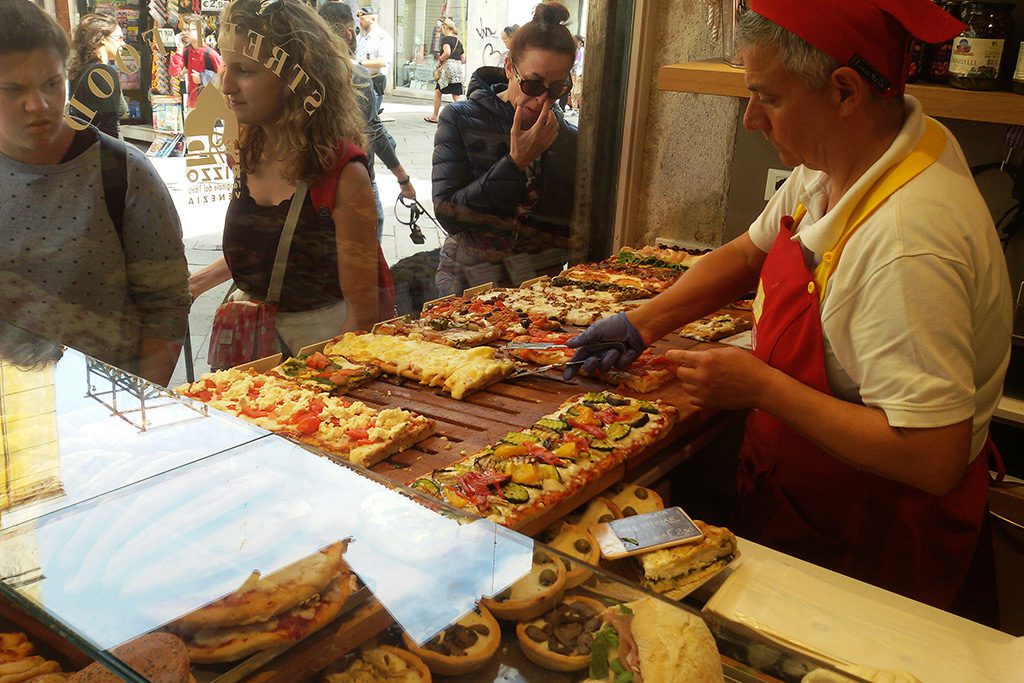
Tramezzini
Ever heard of Tramezzini? They are triangles of soggy, unroasted toast, but that doesn’t matter since the bread is only the wrapper for the delicious fillings.
These are not a couple of thin slices, nope, they are a big heap of the finest Italian delicacies: prosciutto, egg, gamberi, which are shrimps, carciofi, in English artichokes, radicchio, you name it. To help the shredded stuff hold together, they are stirred with just the right amount of mayonnaise to a heavenly mixture and then bedded between two slices of toast.
It’s good that the toast is mushy because this way, there is more capacity for the filling.

I limit myself to three pieces in one meal, but let me tell you, the choice is far harder than the soft bread.
The juiciest tramezzini are waiting for you just around the corner from the Accademia at
Italian Etiquette
At Italian bars, there are often at least two different prices depending on where and how you enjoy your treat. If you grab your tramezzino to go or devour it quickly standing al banco, hence, at the bar, you pay a fraction of what they charge if you sit down at a table and order comfortably al tavolo. The price difference can be significant, to say the least, especially in tourist areas. On the other hand, I often have a coffee and a bite not because I’m hungry but because I want to sit down for a couple of minutes, hence, I bite the bullet. Don’t even think about ordering at the bar and then sitting down. Even if they don’t say anything, which isn’t even probable, you’ll definitely be the ugly tourist.
A great place for a small panino and a cheap glass of tasty wine is the hole-in-the-wall Bacareto da Lele. Just a few steps from the Piazzale Roma, it’s a great place for a quick bite in the morning. Don’t be surprised to find their local patrons already enjoying a glass of wine at that hour. Since they are open from 6 a.m. to 8 p.m., you have plenty of time to join them even after your sightseeing tour. On Saturday, however, they already close at 2 p.m., and they are closed on Sunday.
Aperitivo
I don’t really get the Aperitivo concept, but I still love it. Why I don’t get it? Because an aperitif is supposed to tickle your appetite for a complete meal to follow.
In Italy, the Aperitivo often is a complete meal – and in comparison darn cheap: at the not-over-touristy places you pay between €uro 5 and 8 for an Aperitivo that includes a glass of something like a Spritz and a small buffet with all sorts of niblets. Sometimes, it’s only some potato chips or pieces of bruschetta, but at times, it’s really fancy stuff like tomatoes with crab stuffing or some nice pasta.

The best place to get a delicious Aperitivo is surprisingly located on the very exposed arterial street Strada Nova. It is called Cantina Vecia Carbonera and is located right at the corner of the bridge over Rio Terà de la Maddalena.
As they are closed on Mondays, you might want to just cross the bridge, and right at the corner is a teeny-tiny business called Camin Storto. Their Cicchetti are of excellent quality – make sure to sample their polpette, hence, meatballs, if you’re not a vegetarian. In that case, go for the cubes of grilled mozzarella and gorgonzola – you won’t regret it!
Delis and Supermarkets
If you don’t want to hang around at restaurants and still eat Italian and well, supermarkets can be a great option: You can get fresh bread and cheese from the respective counters. There is a variety of salads and antipasti either pre-packed or at the deli counter.

And finally, there is the hot food counter where you can buy grilled chicken and meats and roast potatoes and other yummy foods that you then can enjoy at your accommodation or as a picnic at a park.
However, do not sit on the stairs of churches or bridges – either resting or picnicking: Venice installed pretty strict laws on how to behave in the city since many visitors didn’t behave very respectfully.

Mind you, Venice is still a city and not a theme park.
Restaurants
Of course, apart from all these snacks, you will be sampling throughout the day, there comes a moment for a seated meal. Blessedly, there are still some good options at Venice that are not a complete rip-off – here they are:
Cà D’Oro alla Vedova
Cannaregio 3912
30121 Venice

Rosticceria San Bartolomeo/Rosticceria Gislon
Sottoportego della Bissa 5424
(Close to Rialto)
30121 Venice
Trattoria dalla Marisa
Fondamenta San Giobbe
Cannaregio 652/B
30121 Venice

Usually, I’m not a dessert person – unless it’s cheese. However, Italian food is just so amazing – even when it comes to dolci, hence, sweets.
My absolutely favorite pasticceria is named…Dolce Vita, the sweet life. Actually, I have nothing to add. Oh wait, there is one thing: One of the best gelato places is just across the street.
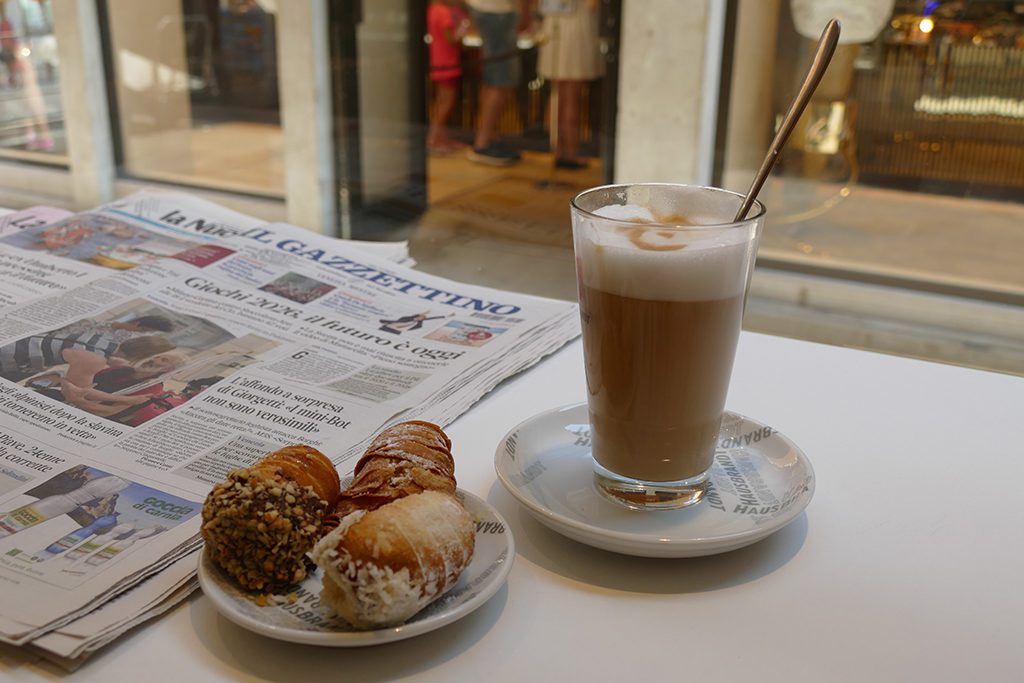
Dolce Vita
Ruga dei Spezieri 378
30125 Venezia
Free Drinks
Like in many places around Italy, you can save some money – and the environment more plastic – if you drink the water from the fountains you find in many places and on basically every square.
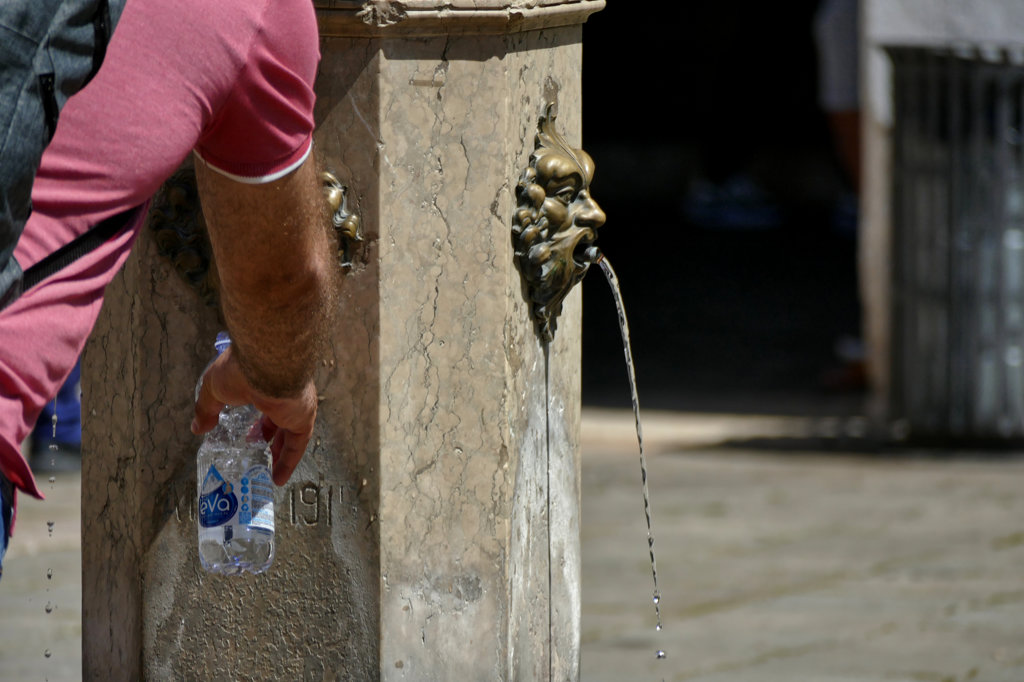
Yes, for you Italy-rookies, those fountains might not look that trustworthy but don’t worry, unless there is a clear sign stating otherwise, it is tasty clean drinking water.
Glass Souvenirs
Venice is a very touristy place and this comes with loads of nicknack. There are all kinds of magnets and t-shirts and aprons and other trash. But there are also agendas made from quality leather and hand-made paper. I don’t like the masks, but I love the sealing wax in many colors and the artsy seals coming with it.
And although I’m usually not the kitschy kind, I love some of the glass figurines. While the cheap kind was probably pressed in a Chinese factory, there are still some vendors selling the true stuff made right in Murano or at least another part of Venice.

If you want some truly nice high-quality glass souvenirs, there are two shops in the Centro Storico I can recommend.
They are both in the San Polo neighborhood which is a less touristy part of Venice – provided that there is a less touristy part in all of Venice.
Dosana is on San Polo 1990, and Fabio Calchera is on San Polo 2586. You’ll find both shops on the map below.
Cash And Cards
Until now, 20 European countries replaced their former local currency with the €uro starting in 2002. Obviously, Italy is one of them. The exchange rate is 1 US$ = 0.93 EUR as of July 2024. However, you can check today’s conversion rate on this page.

Cards are accepted basically everywhere and now, since the pandemic, are actually preferred.
Communication And Connection
Since June 2017, no roaming charges apply within the EU if you have a European mobile phone contract. This involves all 27 countries of the European Union as well as Iceland, Liechtenstein, and Norway.
The EU roaming regulation applies to all contracts.
In case European roaming is not available, you can simply connect to the internet. At basically every museum, eatery or café, and, of course, hotel, free WiFi is available.

If you insist on being online 24/7, you can get a SIM card, obviously.
The standard voltage in Europe is 220 V and the frequency is 50 Hz. In Italy, they use three plug types, namely C, F, and L.
Whereby, since nowadays, all these chargers have integrated adapters, in general, the voltage and frequency don’t really matter.
By the way, you’ll find comprehensive travel info in my post World’s Most Complete Travel Information – an indispensable globetrotter-classic.
Say It Right
In Veneto, but also in other parts of Italy, a particular language is spoken alongside Italian. Venetian, which was the official language of the Republic of Venice, differs greatly from standard Italian in terms of pronunciation, syntax, and vocabulary. However, if you’ve learned standard Italian, you’ll be totally fine. If you still need to learn some basic vocabulary or brush up on your knowledge, you can do so babbel. Already the trial lesson supplies you with some useful vocabulary – and it’s free.
Zushini, Gnotchi, Raditcho – I’m bleeding from my ears since I hear these mispronunciations so often. Seriously, guys, it’s not so hard.
So here are some general rules.
Letter C
As in any other Romance language, C is hard when written before A, O, and U, hence, it’s pronounced K. Examples: casa = kasa – house – or cosa = kosa which means thing.
If followed by E or I, it’s tch as in witch. Examples: cena = tchena – which is dinner – or cino = tchino – Chinese. By the way, it makes no difference if there is on C or two.
Now, if a C followed by E or I should be pronounced K, an H is added: bruschetta, zucchini, gnocchi, radicchio – brusketta, zukkini, gnokki, radikkio.
On the other hand, if C followed by A, O, or U should be pronounced tch, they slip a – silent! – I in: ciocolata, ciabatta – tchocolata, tchabatta – forget about the I in-between.
Letter G
The same rules apply to the letter G. If followed by E or I, it’s pronounced like in the word judge. Everyone knows this rule from the word gelato, right?!
If it’s followed by A, O, or U, it’s pronounced like the G in guitar, hence, hard: Lago di Garda.
To make it sound hard in front of an E or I, a silent H is added: traghetto or ghirlanda.
On the other hand, to make a G sound soft in front of A, O, or U, they slip a – again: silent! – I in: giardino, Giotto – jardino, Jotto.
Last but not least, let’s get back to the Gnocchi: gn is pronounced like ñ in Señor. So it’s basically ñokki you’re ordering at your favorite Italian restaurant. Buon appetito!
One Or Two?
What seems to be a bit tricky for foreigners is the Italian plural. Albeit, it’s not that complicated. Apart from a few neglectable exceptions, if a noun ends with an a, the plural ends with an e. In general, those are female nouns. Hence, one pizza becomes two pizze – and by no means pizzas!
A noun ending with an o gets an i at the end if it’s a plural. Those are male nouns. One gelato becomes various gelati.
Hence, if you order one sandwich, it’s a panino. If you order panini, they should give you at least two. I prefer tramezzini, anyway – therefore, I never order just one tramezzino.
Nouns that end with an e also have an i at the end. Those can be either female or male, but are far more seldom.
Map
Here’s an overview of the places mentioned in this post.
Clicking on the slider symbol at the top left or the full-screen icon at the top right will display the whole map including the legend.
Pinnable Pictures
If you choose to pin this post, please use one of these pictures:






Did You Enjoy This Post? Then You Might Like Also These:
How to Visit the Biennale di Arte in Venice in 2022
24 hours in MILAN
TORCELLO – a church, a bridge, and 15 residents
location location location – my adventurous accommodation choices
How to Visit the Biennale di Arte in Venice 2019
MURANO – BURANO – TORCELLO: A Self-Guided Island Tour
LA SPEZIA and PORTO VENERE – Precious Gems on the Ligurian Coast
How to Visit the Biennale di Arte in Venice in 2024
Note: I’m completing, editing, and updating this post regularly – last in July 2024.
* This is an affiliate link. If you book through this page, not only do you get the best deal. I also get a small commission that helps me run this blog. Thank you so much for supporting me!








This was a fantastic read! Thank you for all those great information!
Glad I could help 😉
Helpful tips because Venice is not cheap. You showed greatly how you can save and also see the attractions and try the local cuisine. I was in winter, and it was much more affordable. And I also used water buses.
I was blown away by the number of those water buses. It’s such a greatly elaborated system! 🙂
I was in Venice pre-pandemic and in April. I always travel in shoulder season due to less crowds and your travel dollars can stretch that much further. Great round up of budget saving tips. The one I didn’t know about and was very intrigued was the Biennale di Arte. That’s worth travelling in odd-numbered years just to be able to get a glimpse inside many of the old palazzi.
So true for all of those cities suffering from over-tourism.
I have never been to Venice, but it is on my bucket list. I am always looking for ways to see places on a budget and try to vacation for under $50 per day. I will have to reference your post when I visit Venice.
I was only in Venice as a quick layover. I would love to go back. What I did learn from my trip was to pack light! Getting in and out of a gondola is very difficult with heavy suitcases!
Yes, you’re right – I’m also recommending that in my post. Also dragging your suitcase over the cobblestone alleys is hard 😀
What a fantastic, in-depth roundup of things to do while on a budget! I visited Venice six years ago and loved it, it’s such a unique city.
It surely is – so very special 🙂
Very helpful post as I’ve heard it’s a very expensive city! Would love to visit!
I would love to visit Venice but have heard it’s expensive. Good to hear you can do some things even if you are on a budget.
For a fun visit on a budget, this post is all you need 😉
Venice is SO expensive! I really feel like it makes the whole city lose part of its charm. Finding budget-friendly options to still enjoy it is very helpful. we can’t have too many guides like that
I find the prices for accommodation especially crazy. Therefore, I always stay in Mestre. I need 15 minutes by bus to get to Venice, but I save big big bucks 😀
Great tips to save money on a trip to Venice. I remember the first time we went to Venice it was in January and it was freezingly cold. But I guess March or November would be a good time. I agree with the strange concept of Aperitivo. Recently we got a whole pizza with the Aperol!
Hahaha – an entire meal – how cool is that?! Yes, winters are very cold in Venice – especially with the wind and the acqua alta. However, if you want to see all the museums, it doesn’t really matter.
Italy, and I say this as an Italian, offers truly unique places in the world, but I am the first to recognize that it has prohibitive prices. Even I didn’t know some of the savings tips in my own country. So thank you!
Actually, it strongly depends. The gastronomy in Venice is quite pricey – because they can get away with it. Also, the poor Venetians are paying a high – ecological – price for their economic wealth 😉
Great article, just what I wanted to find.
Very glad you did! Enjoy Venice 🙂
Highly descriptive article, I liked that bit.
Will there be a part 2?
As soon as I go back to Venice, there might be 🙂
I needed to thank you for this good read!! I definitely loved every bit of
it. I have you saved as a favorite to check out
new stuff you post…
I blog often and I genuinely appreciate your content.
This great article has really peaked my interest. I’m going to book mark your website
and keep checking for new information about once per week.
I subscribed to your newsletter as well.
It’s fantastic that you are getting ideas from this article as well as
tips on how to save money.
Great post. I was checking constantly this blog and I am impressed!
Extremely useful info specially the last
part 🙂 I care for such info much. I was looking for this
particular info for a long time. Thank you and good luck.
Very nice post. I just stumbled upon your weblog
and wished to say that I’ve truly enjoyed surfing around your blog posts.
After all I will be subscribing to your newsletter and I hope you write again very soon!
Appreciate the recommendation. Let me try it out.
…and you won’t be disappointed 😀
Thanks for sharing your thoughts. I truly appreciate your efforts
and I will be waiting for your further write ups thank you once again.
You’re welcome – always happy to help with your travel planning 🙂
We would never visit Italy in the summer because of the crowds, so would definitely plan a shoulder season visit. But I do see why visiting in the winter might bring savings on many things. Visiting Murano during the Beinnale di Arte and getting views of the old palazzi is definitely something we should look into. We stayed in Verona once and did Venice as day trips. So staying outside on the Veneto mainland might work for us. We can’t wait to visit again!
I was there in the summer when my daughter was still in school. It’s full, it’s hot – and yet, it’s beautiful 😀
Keep on working, great job!
Hello! I simply want to give you a huge thumbs up for the great info you’ve got right
here on this post. I’ll be coming back to your blog for more
soon.
Quality articles or reviews are crucial to interest the people to go to see the web site,
that’s what this web page is providing.
Keep this going please, great job!
Good day I am so excited I found your web site, I really found
you by accident, while I was browsing
for something else, Anyhow I am here now and would just like to say thanks
for a fantastic post and an all round interesting blog.
Can you tell us more about this? I’d want to find out some
additional information.
Actually, I believe my post is quite comprehensive. However, if you have questions, just write them here in the comment section – or send me a message using the form on the right side bar.
An outstanding share! I’ve just forwarded this onto a coworker
who has been doing a little homework on this. And he actually bought
me breakfast simply because I discovered it for him… lol.
So let me reword this…. Thanks for the meal!!
But yeah, thanx for spending some time to talk about this topic
here on your website.
I love Venice! The last time I visited was in December & it was beautiful. Sunny but very cold & almost empty of tourists. I loved arriving by train into the centre & walking out to see the canals & then going back to the airport by boat was a unique experience too. Great post!
It’s an remarkable article in support of all the internet people; they will
get benefit from it I am sure.
I am hoping to visit Venice next weekend, just for a day trip, so this comes at the perfect time. I have been on a gondola before, so it will be vaperettos for me. It may be raining so I will get a Museum Card and stay dry. Thank you for all the useful tips!
This was so helpful, as I have Venice on my bucketlist. I loved how you described the foods. I would spend the entire day stopping for the street food. Like you, I prefer food lacking in vitamins and nutrients lol.